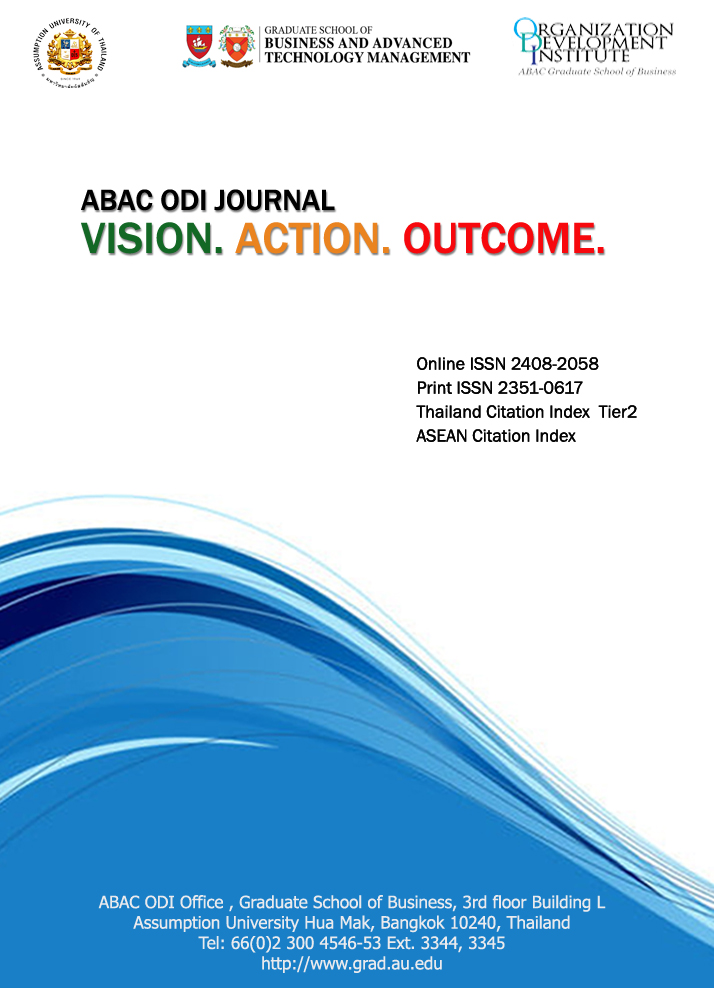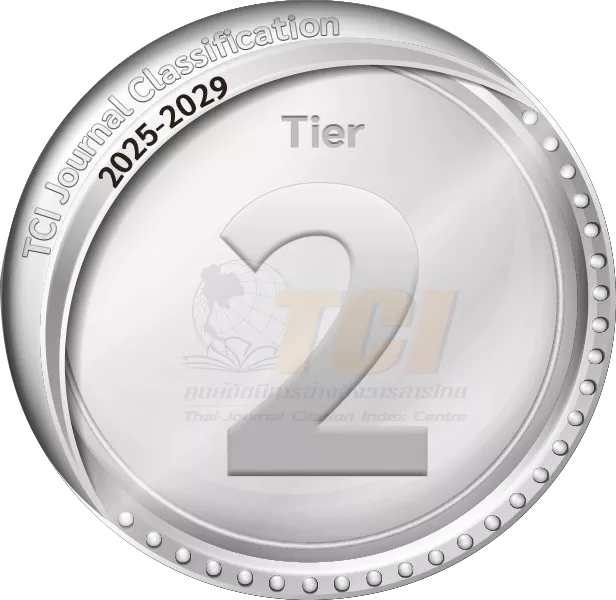Organizational Effectiveness Enhancememt Through the Lens of Lifelong Learning
DOI:
https://doi.org/10.14456/abacodijournal.2021.16Abstract
Due to the 21st century's global economic competitiveness, organizations increasingly recognize the need for ongoing learning and development, particularly non-formal education, and informal learning in the workplace, to achieve business results. This study aims to examine the impact of lifelong learning on organizational effectiveness and its importance. In the methods and resources, a systematic literature review with inclusion and exclusion criteria and a documentation analysis technique were used. Additionally, the meta-analysis technique was used to identify, select, conceptualize, and analyze data. The findings affirm that non-formal education providers are necessary for ongoing training and development, while informal learning is a cost-effective approach to increase education. This paper presents the concepts of lifelong learning in the European and Thai contexts as a major organizational effectiveness element. The current situation of Covid-19 through the perspective of lifelong learning is also presented to support the transformative learning theory. The discussion and conclusions describe that lifelong learning is a critically important factor that has a major impact on organizational effectiveness; meanwhile, leaders and Human Resources Development play vital strategic roles as learning system providers to enhance organizational effectiveness.
References
Anderson, L. W., & Bloom, B. S. (2001). A taxonomy for learning, teaching, and assessing: A
revision of Bloom's taxonomy of educational objectives. Longman.
Aydin, B., & Ceylan, A. (2009). Does organizational learning capacity impact on organizational
effectiveness? Research analysis of the metal industry. Development and Learning in Organizations: An International Journal, 23(3), 21-23
Barros-Contreras I., Palma-Ruiz J.M. (2020) Knowledge Accumulation and Its Effects on
Organizational Effectiveness in Family Firms. In: Leitão J., Nunes A., Pereira D., Ramadani V. (eds) Intrapreneurship and Sustainable Human Capital. Studies on Entrepreneurship, Structural Change and Industrial Dynamics. Springer, Cham. https://doi.org/10.1007/978-3-030-49410-0_10
Bazzoli, A., Curcuruto, M., Morgan, J. I., Brondino, M., & Pasini, M. (2020). Speaking up about
workplace safety: An experimental study on safety leadership. Sustainability, 12(18), 7458.
Bento A., Bento, R. & White, L. F. (2014). Strategic performance management systems: Impact
on business results. Journal of Computer Information Systems, 54 (3), 25-33.
Bowl, M. (2017). Adult education in neoliberal times. Springer International Publishing.
Berman, N. (2020). A critical examination of informal learning spaces. Higher Education
Research & Development, 39(1), 127-140.
Cameron, K. (1980). Critical questions in assessing organizational effectiveness.
Organizational Dynamics. 4 ( 2) ,66-80.
Cameron, K. (2015). Organizational effectiveness. Wiley Encyclopedia of Management.
Cappelli, P. and Tavis, A. (2016). The performance management revolution. Harvard Business
Review, 94 (6), 58-67.
Charungkaittikul, S., & Henschke, J. A. (2014). Strategies for developing a sustainable learning
society: An analysis of lifelong learning in Thailand. International Review of Education, 60(4), 499-522.
Chiu, C. N., & Chen, H. H. (2016). The study of knowledge management capability and
organizational effectiveness in Taiwanese public utility: the mediator role of organizational commitment. SpringerPlus, 5(1), 1520.
Clardy, A. (2008). The strategic role of human resource development in managing core
Competencies. Human Resource Development International. 11 ( 2) , 183-197
Dainty, A., Cheng, M. and Moore, D. (2004). A competency-based performance model for
construction project managers. Construction Management and Economics. 22 ( 8) , 877-886.
Delery, J., & Gupta, N. (2016). Human resource management practices and organizational
effectiveness: Internal fit matters, Journal of Organizational Effectiveness: People and Performance. 3 (2), 139-163
EC–European Commission. (2002). European report on quality indicators of lifelong learning:
fifteen quality indicators. Report based on the work of the Working Group on Quality Indicators. European Commission, Brussel
Esfahani, A. N., Hosseini, M., Fanaei., H., & Azam, M. (2013). Evaluate the effectiveness of
group work and the development of methods on Esfahan group work gas. International Journal of Academic Research in Business and Social Sciences, 3(11) 531-548.
Forbes, M. (2007). Governance and organizational effectiveness: Toward a theory of government
Performance. Public Management Research Conference. Tucson, Arizona.
Hallahan, K. (2015). Organizational goals and communication objectives in strategic
communication. The Routledge Handbook of Strategic Communication. Taylor & Francis
Group Publisher
Herman, R. D., & Renz, D. O. (1999). Theses on Nonprofit Organizational Effectiveness
Nonprofit and Voluntary Sector Quarterly, 28(2),107-126. https://doi.org/10.1177/0899764099282001
Henschke, J. (2014). An international perspective on reorienting traditional higher education
institutions toward lifelong learning. Fourth international conference on adult education: Adult education in universities: Local and regional perspectives. 27–30 April . Iasi, Romania
Holford, J., Riddell, S., Weedon, E., Litjens, J. & Hannan, G. (2008). Patterns of lifelong
learning: Policy and practice in an expanding Europe. Lit-Verlag, Vienna.
Hubackova, S. & Semradova, I. (2014). Research study on motivation in adult education,
Procedia - Social and Behavioral Sciences, 159, 396-400.
Isoraite, M. (2004). Evaluating efficiency & effectiveness in transport organizations. Transport,
(6) 240-247
Jakobi, A. P. (2009). Global education policy in the making: International organisations and
lifelong learning. Globalisation, Societies and Education, 7(4), 473-487.
Kerr, S., & Landauer, S. (2004). Using stretch goals to promote organizational effectiveness and
personal growth: General Electric and Goldman Sachs. Academy of Management Executive, 6 (18) 134- 138.
Lee, H. W. (2017). Sustainable leadership: An empirical investigation of its effect on organizational effectiveness. International Journal of Organization Theory & Behavior . 20(4), 419-453.
Marler, J.H. (2012). Strategic human resource management in context: a historical and global
Perspective. Academy of Management Perspective. 26 (2)6 -11.
Marsick, V., Watkins, K., Callahan, M., & Volpe, M. (2009). Informal and incidental learning in
the workplace. In M. C. Smith (Ed.), Handbook of research on adult development and learning (pp. 570–600). Routledge Press
McKinsey (2014). Building organizational capabilities: McKinsey global survey results.
McKinsey report. www.mckinsey.com/business functions/organization/our-insights/ building-organizational-capabilities-mckinsey-global-survey-results .
Macpherson, A. & Holt, R. (2007). Knowledge, learning and small firm growth: A
systematic review of the evidence. Research Policy. 36 ( 2) , 172-192.
Mensah, H. K., Akuoko, K. O., & Ellis, F. (2016). An empirical assessment of health workers'
organisational commitment in Ghana: A comparative analysis. International Journal of Business and Management, 11(3), 183-192.
Mezirow, J. (1991). Transformative dimensions of adult learning. Jossey-Bass.
Nawaz, N. (2020). Assessment of organizational effectiveness a comparative study in between
public and private sector. International Journal of Psychosocial Rehabilitation, 24(10),
-1807
Organization for Economic Co-operation and Development. (2018). Summary report on
the new comprehensive global database of Per- and Polyfluoroalkyl Substances (PFASs). Publications series on risk management 39, 2018, http://www.oecd.org/officialdocuments/publicdisplaydocumentpdf/?cote=ENV-JMMONO(2018)7&doclanguage=en
Office of the National Economic and Social Development Board. (2016). Thailand 20-year
national strategic plan. http://nscr.nesdb. go.th/wp-content/uploads/2019/10/National-Strategy-Eng-Final-25-OCT-2019.pdf
ONIE (Office of Non-formal and Informal Education). (2008). Non-formal and informal education
promotion act B.E. 2551. ONIE
Parke, M. R., & Seo, M. G. (2017). The role of affect climate in organizational effectiveness. Academy of Management Review, 42(2), 334-360.
Pichayasathit, S. (2001). A learning society for the promotion of lifelong learning. In UNESCO
(Ed.), Lifelong learning in Asia and the Pacific (pp. 124–125). UNESCO Bangkok.
Ratana-Ubol, A., & Henschke, J. A. (2015). Cultural learning processes through local wisdom: A
case study on adult and lifelong learning in Thailand. International Journal of Adult Vocational Education and Technology (IJAVET), 6(2), 41-60
Reimers, F., Schleicher, A., Saavedra, J., & Tuominen, S. (2020). Supporting the continuation of
teaching and learning during the COVID-19 pandemic. OECD, 1(1), 1-38.
RTG (Royal Thai Government). (1999). National Education Act B.E. 2542.
RTG (Royal Thai Government). (2002). National Education Act. Amendment (issue 2) B.E. 2545.
RTG (Royal Thai Government). (2007). Constitution of the Royal Kingdom of Thailand B E.
Senasu, K., & Virakul, B. (2014). The relative effects of personal CSR and organizational CSR on
work-life satisfaction and job satisfaction. City of Edinburgh and Craiglockhart Campus
Sharma, N., & Singh, R. K. (2019). A unified model of organizational effectiveness. Journal of
Organizational Effectiveness: People and Performance. 6 (2),114-128
Shet, S. V., Patil, S. V., & Chandawarkar, M. R. (2019). Competency based superior performance
and organizational effectiveness. International Journal of Productivity and Performance Management. 68(4), 753-773
Simonds, D. & Pederson, C. (2006). HRD: The shapes and things to come. Journal of
Workplace learning. 18 (2),122-135
Smith, A. (2002). Integrating lifelong learning perspectives. In C. Medel-Añonuevo (Ed), The EU memorandum on lifelong learning. Institute for education. (p.47)
Stromquist, N.P., & Lozano, G. (2017). Scratching the surface: The hidden functions and
contributions of popular universities. In J. Holford, P. Jarvis, M. Milana, R. Waller,S. Webb(Eds) . Handbook of adult and lifelong education and learning . Palgrave McMillan.
Swanson, R.A., & Holton, E.F. (2009). Foundation of human resource development.
Berrett – Koehler
Tang, H. (2017). A study of the effect of knowledge management on organizational culture and
organizational effectiveness in medicine and health sciences. Eurasia Journal of Mathematics, Science and Technology Education, 13(6), 1831-1845.
The Evaluation Forum. (2003). Guide to evaluating leadership development programs.
Thummakul, D., Kaeodumkoeng, K., Prasertsin, U., Sinjindawong, S., & Makmee, P. (2012). The
development of a happy workplace index. International Journal of Business & Management Studies, 1(2), 527-536.
Vithayaporn, S., & Ashton, A. S. (2019). Employee engagement and innovative work behavior: A
case study of Thai airways international. ABAC ODI Journal Vision. Action. Outcome, 6(2), 45.
Wang, Z. (2005). Organizational effectiveness through technology innovation and HRM
strategies. International Journal of Manpower. 26(6), 481-487
Watkins, K. E., Marsick, V., & Kim, Y. S. (2012). The impact of lifelong learning on
organizations. In Second International Handbook of Lifelong Learning (pp. 859-873). Springer
Watkins, K., & Milton, J. (2009). Diagnosing the learning culture in public health agencies.
International Journal of Continuing & Lifelong Learning. 2 (1), 53–62.
Werner, J. M. & Desimone, R. L. (2006). Human resource development: Foundation, framework, and application. Cengage Learning Publications.
Wu, Z., & McGoogan, J. M. (2020). Characteristics of and important lessons from the coronavirus
disease 2019 (COVID-19) outbreak in China: Summary of a report of 72 314 cases from the Chinese Center for Disease Control and Prevention. JAMA, 323(13), 1239–1242. https://doi.org/10.1001/ jama.2020.2648.
Zollo, L., Laudano, M. C., Boccardi, A., & Ciappei, C. (2019). From governance to organizational
effectiveness: the role of organizational identity and volunteers' commitment. Journal of Management and Governance. 23(1), 111




